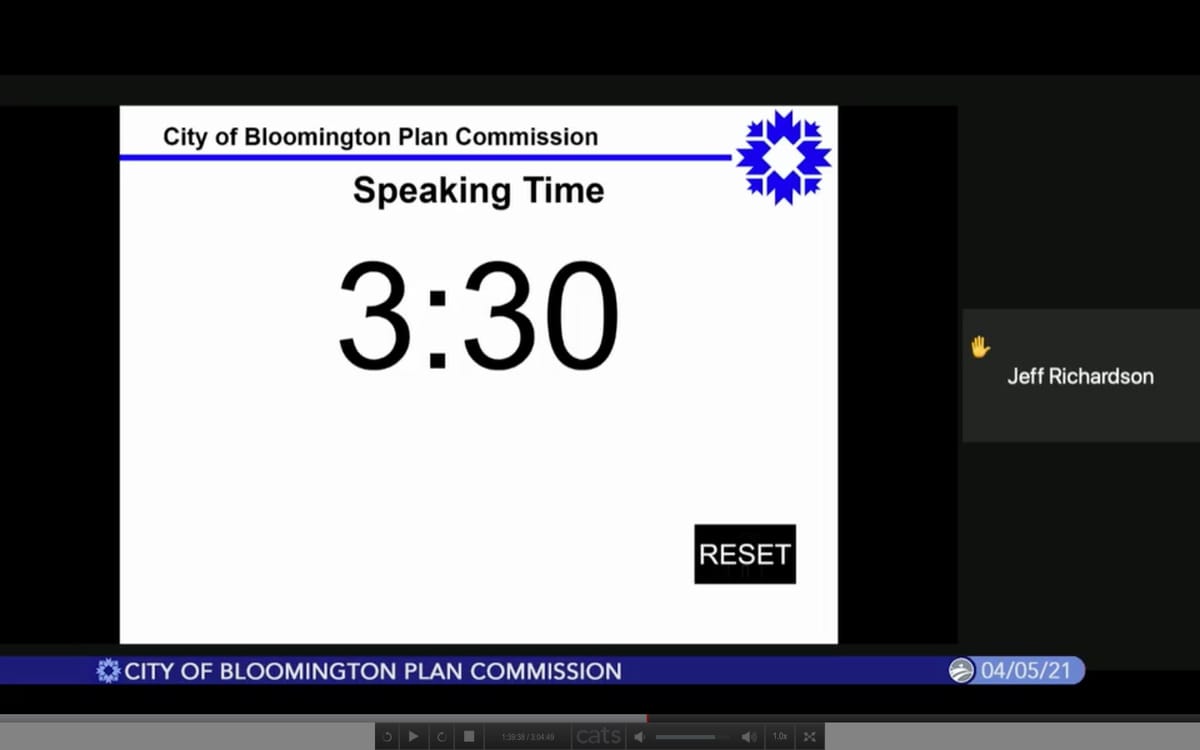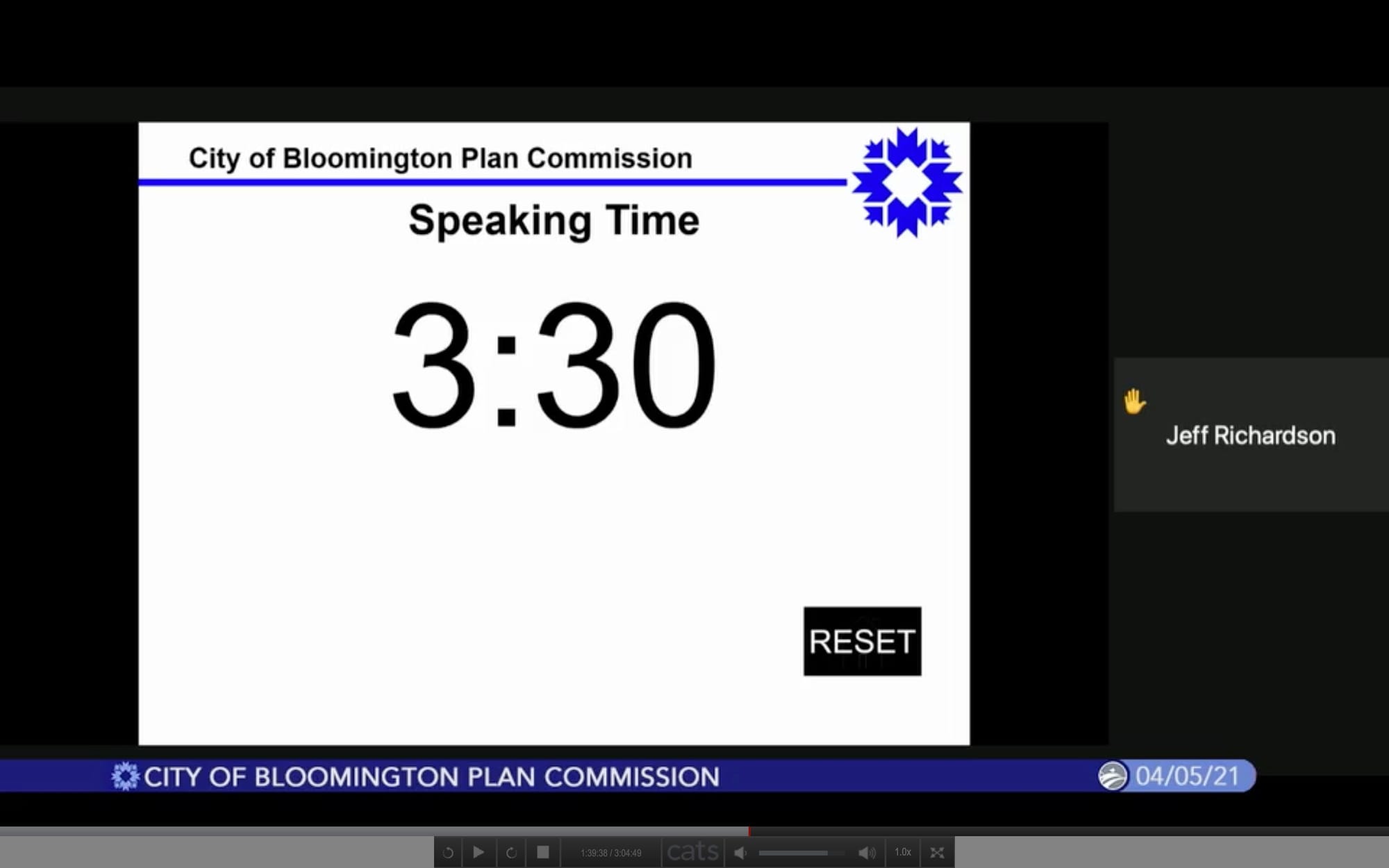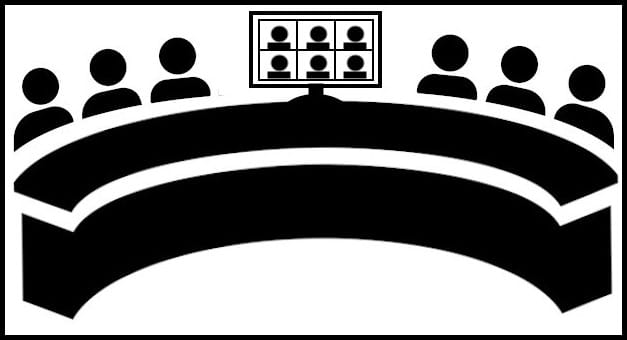Bloomington city council adopts resolution on electronic meetings policy, frustrated by lack of timing device for speakers



At a special session on Wednesday, Bloomington’s city council adopted a resolution on a policy that will allow a subset of councilmembers to continue to attend meetings using electronic communication, instead of attending in person.
The policy adopted by the city council comes as Indiana governor Eric Holcomb’s current emergency health order is set to expire on May 31. It’s the governor’s emergency order that has allowed governing bodies that are otherwise required under Indiana’s Open Door Law to meet in person, to meet instead on electronic video platforms like Zoom.
What makes local policies on electronic meeting participation possible is a new state statute enacted by the state legislature during this year’s session. Under HEA 1437, members of a governing body can, in a more limited way, still participate in meetings from a distance, by using electronic platforms.
The ability to conduct “hybrid” meetings—where some city council members participate remotely, and some appear in person in council chambers at city hall—relies on some upgrades to the technology deployed in the chambers.
The upgrades to council chambers don’t include a way for the president of the council and the parliamentarian to manage a visible and audible time clock for public speakers and for councilmembers.
That’s something that drew some complaint from councilmember Steve Volan, which was echoed by councilmembers Ron Smith and Sue Sgambelluri.
Volan pointed out that he had raised the question in January 2020, before the pandemic was even an issue.
Bloomington’s director of IT, Rick Dietz responded to Volan by saying, “In an ideal world, we would have something that would both integrate with, and work in the physical environment and also work transparently online.”
Dietz added, “To date, we haven’t been able to identify what that kind of solution would be. But we do anticipate being able to field something physically, on site that accommodates the needs that that you describe, but not in a networked fashion.”
The council’s administrator/attorney, Stephen Lucas, had introduced the general topic of the technology upgrades by saying, “The city’s IT department has worked diligently to help prepare for a return to in-person meetings and especially to hybrid meetings, where we may have members participating both in person and electronically, as well as members of the public participating in those different ways.”
Sgambelluri was less concerned about the ideal solution that Dietz described, than about some kind of partial solution.
Sgambelluri said: “I understand that we don’t have a tool that will cut across all different platforms, and that everybody will see. But what can we do now? Can we at least project timers in chambers? Or can we at least project timers online?”
Dietz indicated that physical devices exist that could be placed on the dais that would give a red-green-yellow status, as well as numerical countdowns, which would be visible to people who are speaking and facing the council. Such devices would allow people to know how much time is left in their speaking turn.
Sgambelluri wanted to know if that kind of device could be acquired and installed by the time the council resumes meeting in-person.
Dietz responded by saying he had been working with Lucas “to ensure that we’re meeting as many of the requirements that the council has as we can, in the device that we ultimately end up selecting.”
In pre-pandemic times, the city plan commission, which holds its meetings in city council chambers, projected its timer for speakers on the large multi-panel screen hanging on the wall of city council chambers. For Zoom meetings, the plan commission has displayed a countdown timer for one of the video squares.
The policy that that was adopted by the city council on Wednesday is similar to those that have already been adopted by other local governing bodies, including the Monroe County board of commissioners, the Monroe County council, the Monroe County board of public health, and Bloomington’s utilities service board.
For remote electronic participation in meetings, the new statute requires that governing bodies adopt a written policy “establishing the procedures that apply to a member’s participation in a meeting by an electronic means of communication.”
According to the policy adopted by the city council’s resolution, rank-and-file members of the public are supposed to be able to participate remotely in future meetings of the council, even if there is no emergency order in place.
Section 7 of the policy starts like this: “Members of the public shall be able to attend and observe meetings of the council via electronic means.”
Named in the new statute as examples of meetings where remote participation is not an option, include those occasions when decisions are made about: adopting a budget; making a reduction in personnel; initiating a referendum; establishing or increasing a fee; or establishing or increasing a penalty.
The new state statute says that a member of a governing body can’t attend more than two meetings using an electronic platform, subject to certain exceptions. The statute also requires that for any meeting, at least half of the members of a governing body attend in person.
Among the issues that councilmembers spitballed on Wednesday is the potential challenge of deciding which four councilmembers would be allowed to participate remotely, if more than four wanted to do that.
As council president Jim Sims put it, “At this point, there is no answer that I see on there. Being fluid, I’m hoping that part of the criteria for making the meetings will kind of take care of that.”
Wednesday’s resolution passed on a 7–2 vote. Absent were Dave Rollo and Susan Sandberg.




Comments ()